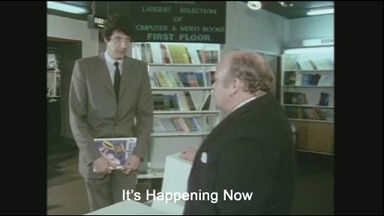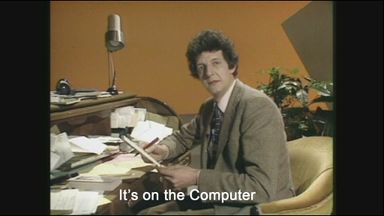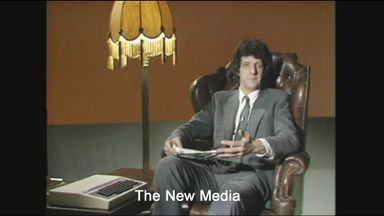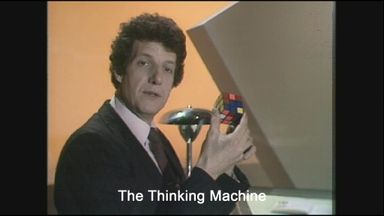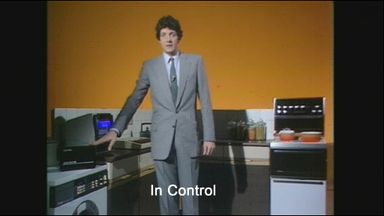The Computer Programme
6. Moving Pictures
Clips from this programme
The future of computers is going to be more than figures and letters but also sound and moving pictures
Duration: 00:45Mac is at the London Planetarium where computer generated images project the night sky, simulating the Voyager spacecraft fly past of Saturn well before the spacecraft reached it.
Duration: 01:23Computer graphics are increasingly used in advertising - for example in an animated shaving sequence and in experimental art forms
Duration: 00:50A couple of examples: wire frame animation of the Chicago skyline (probably created in real time) and a relatively low resolution seascape with sun and moon setting
Duration: 01:03How to get the computer to draw graphics - a graphics tablet could be used instead of the keyboard.
Duration: 01:13Chris Serle's sweater is unravelled to show that even when just a single thread the pattern information is still there. The analogy shows how the bit pattern in a computer programme can be rearranged to produce different results on a screen just as alteration of the coloured areas on the threads can produce different sweaters.
Duration: 02:57A project at the Royal College of Art to produce a visual bus route map runs into unexpected problems coping with something that we can do easily - drawing curved but parallel lines. The simplest looking problems often turn out to be very difficult for a computer. Refining this particular program to draw these parallel lines shows some of the challenges faced by the coder.
Duration: 04:16Visualising business information becomes easier if it's in graphical form. Mac uses an early form of computer mouse on a business machine to display results and then explains the code for drawing a sales graph on a BBC Micro, including calling up sub routines and using loops.
Duration: 05:40The 'Speak and Spell' machine was an early example of a dedicated educational computer which can. Getting a computer to recognise speech is more difficult. Mac and Chris use 'Big Ears' - a simple programme to show how pattern recognition can be used to teach a computer to recognise a small vocabulary.
Duration: 02:51Making music - Dr David Ellis plays 'Alphasyntauri' in a recording studio using a synthesiser, and other equipment including lighting effects linked by a MIDI interface and controlled by a microcomputer
Duration: 01:49Closing credits begin over 'Alphasyntauri' played by David Ellis
Duration: 01:22A postscript by Brian Smith of the Royal College of Art, who talks about what a computer can offer an artist.
Duration: 00:46The Computer Programme
1. It's Happening Now
First broadcast: 11th January 1982
Duration 24:51
"Don't expect the computer revolution to happen tomorrow, it's going on all around us." Chris Serle, Ian McNaught-Davis and Gill Nevill begin their exploration of the world of Information Science and ask: 'What can computers do for us? Who is using them now, and where is this technology likely to lead?' Director: FRANK ASH Director: MATT BONEY Producer: PAUL KRIWACZEK
2. Just One Thing After Another
First broadcast: 18th January 1982
Duration 24:53
CHRIS SERLE, IAN MCNAUGHT-DAVIS and Gill Nevill, continue their exploration of the world of information science. Even the most elaborate and sophisticated computer programs are made up of only a few types of relatively simple steps. The art of computer programming lies in combining these into ever more complex combinations. Directors FRANK ASH, MATT BONEY Producer PAUL KRIWACZEK
3. Talking to a Machine
First broadcast: 25th January 1982
Duration 24:23
CHRIS SERLE, IAN MCNAUGHT-DAVIS and GILL NEVILL continue their exploration of the world of information science. The difficulty of communicating with computers is that they are machines and we are people. The common language we share can turn out to be a lot more like English than we might expect. Directors FRANK ASH, MATT BONEY Producer PAUL KRIWACZEK
4. It's on the Computer
First broadcast: 1st February 1982
Duration 24:39
CHRIS SERLE, IAN MCNAUGHT-DAVIS and GILL NEVILL continue their exploration of the world of information science. Storing information is what the great majority of computers are used for. But how much can they hold, and how can the stored information be easily retrieved? Director MATT BONEY Producer PAUL KRIWACZEK
5. The New Media
First broadcast: 8th February 1982
Duration 24:12
CHRIS SERLE, IAN MCNAUGHT-DAVIS and GILL NEVILL continue their exploration of the world of Information Science. 5: The New Media : The greatest public impact of information technology is likely to be in the provision of new means of communication. Directors FRANK ASH, MATT BONET Producer PAUL KRIWACZEK
6. Moving Pictures
First broadcast: 15th February 1982
Duration 24:37
CHRIS SERLE, IAN MCNAUGHT-DAVIS and GILL NEVILL continue their exploration of the world of information science. For many people games, with their elaborate visual displays, are the most commonly encountered aspect of computer technology. But generating sound and pictures from a computer is no different to manipulating text. Director: MATT BONEY Director: Frank Ash Producer: PAUL KRIWACZEK
Now playing
7. Let's Pretend
First broadcast: 22nd February 1982
Duration 24:32
CHRIS SERLE, IAN MCNAUGHT-DAVIS and GILL NEVILL continue their exploration of the world of information science. 7: Let's Pretend: Training space-shuttle pilots, or testing bridges to destruction, is normally too costly or too dangerous to do on the real thing. But by giving a computer an exact description of how a complicated system behaves, it can mimic anything from the British economy to the world's weather. Directors FRANK ASH, MATT BONEY Producer PAUL KRIWACZEK
8. The Thinking Machine
First broadcast: 1st March 1982
Duration 24:30
CHRIS SERLE, IAN MCNAUGHT-DAVIS and GILL NEVILL continue their exploration of the world of information science 8: The Thinking Machine: In spite of years of investment in the development of intelligent machines, computer scientists are still a long way from equalling human thought, let alone surpassing it. The future, however, may yet present us with great surprises. Directors MATT BONEY, FRANK ASH Producer PAUL KRIWACZEK
9. In Control
First broadcast: 8th March 1982
Duration 24:34
CHRIS SERLE, IAN MCNAUGHT-DAVIS, GILL NEVILL 9: In Control: By far the greatest number of computers with which we will come into contact in the future will be invisible. They will be the microprocessors built into many of our domestic appliances, replacing many of the mechanical systems that we use today, with greatly improved reliability, flexibility, and at low cost. Directors FRANK ASH, MATT BONEY Producer PAUL KRIWACZEK
10. Things to Come
First broadcast: 15th March 1982
Duration 24:17
CHRIS SERLE, IAN MCNAUGHT-DAVIS and GILL NEVILL continue their exploration of the world of information science. Things to Come: Information technology has the power to change the face of our society completely by taking over the work of a large majority of the population. But will this be allowed to happen, and which aspects of our economic life are most likely to be affected? Directors MATT BONEY, FRANK ASH Producer PAUL KRIWACZEK













